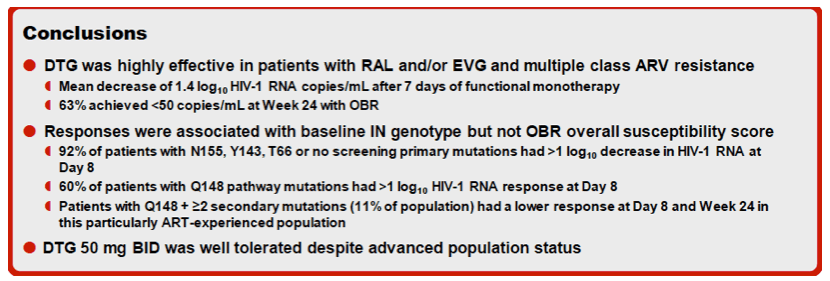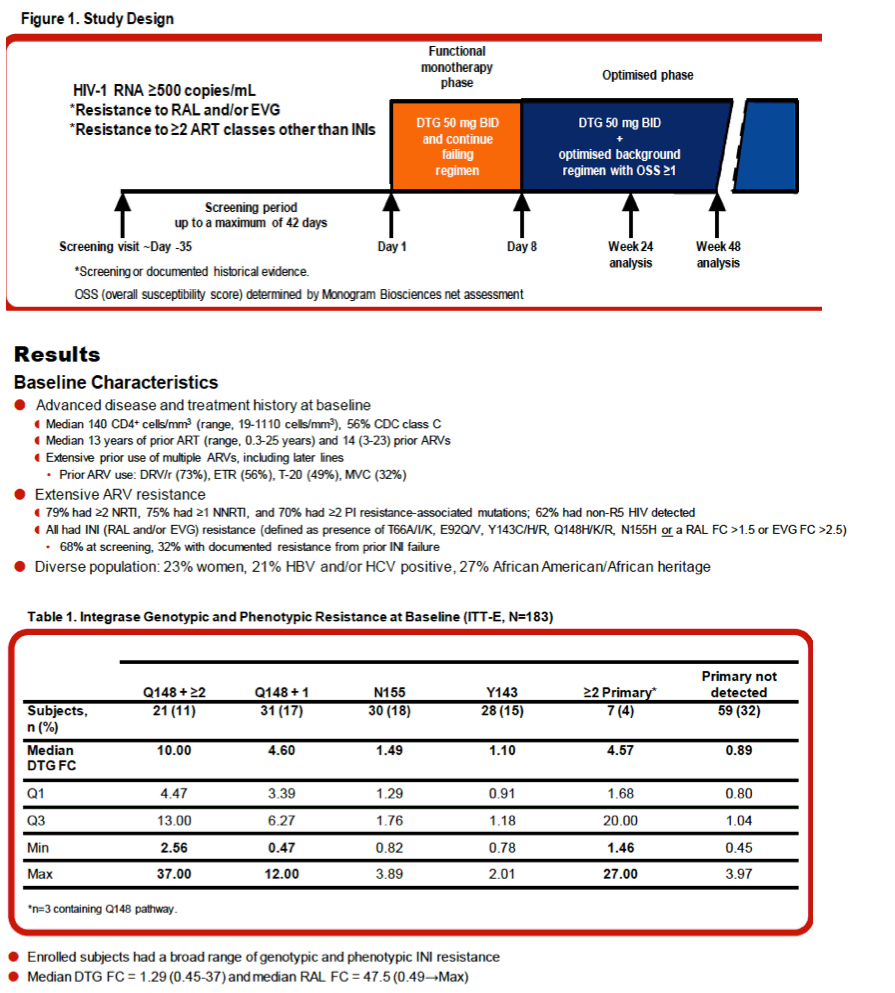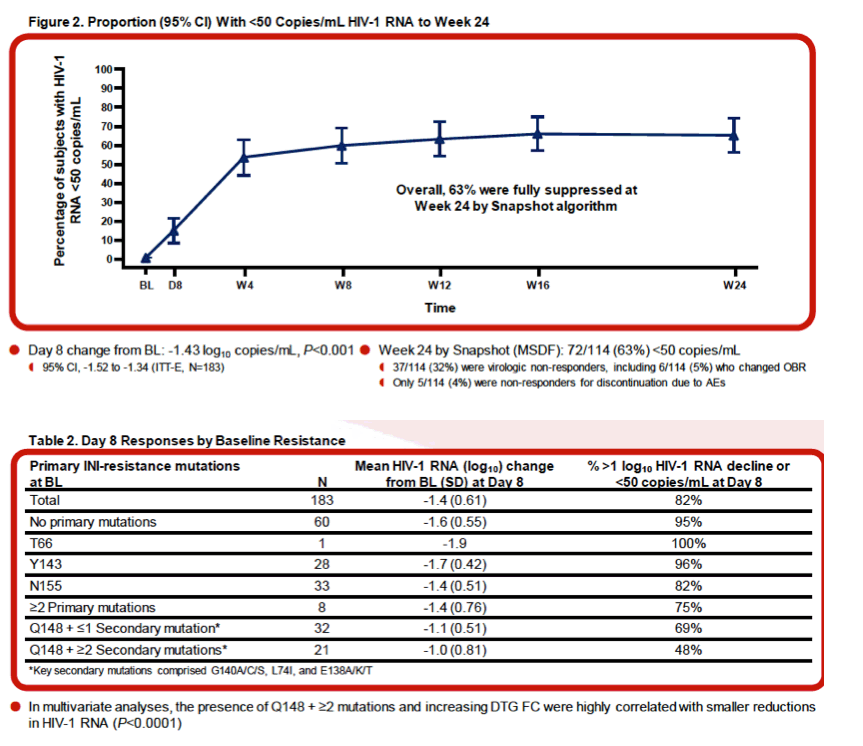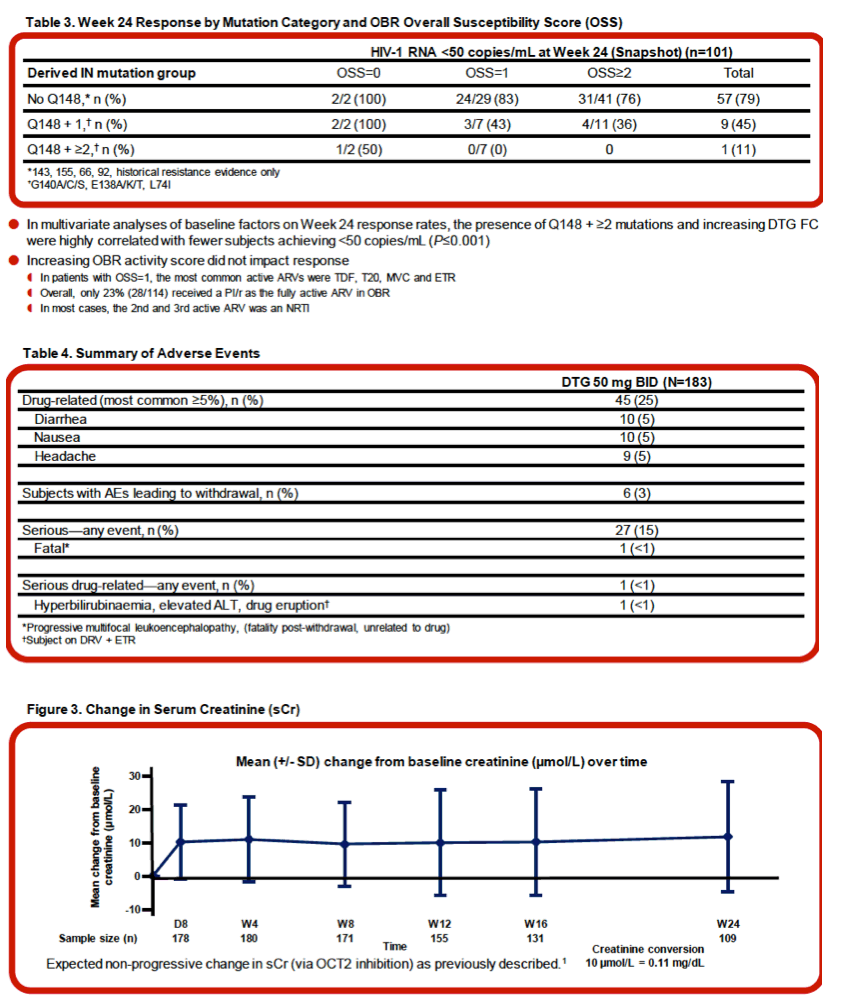 |
 |
 |
| |
Antiviral Activity of Dolutegrevir in Subjects With Failure on an Integrase Inhibitor-Based Regimen: Week 24 Phase 3 Results From VIKING-3 (1) Poster
|
| |
| |
Reported by Jules Levin
Glasgow 2012 Nov 11-15
G Nichols,1 A Mills,2 R Grossberg,3 A Lazzarin,4 F Maggiolo,5 J-M Molina,6 G Pialoux,7 D Wright,8 M Ait-Khaled,9 J Huang,10 C Vavro,1 B Wynne,11 J Yeo9
1GlaxoSmithKline, Research Triangle Park, NC, USA; 2Anthony Mills MD Inc, Los Angeles, CA, USA; 3Montefiore Medical Centre, New York, NY, USA; 4San Raffaele Scientific Institute, Milan, Italy; 5Ospedali Riuniti, Bergamo, Italy; 6Hospital Saint-Louis, Paris, France; 7Hospital Tenon, Paris, France; 8Central Texas Clinical Research, Austin, TX, USA; 9GlaxoSmithKline, London, UK; 10GlaxoSmithKline, Mississauga, ON, Canada; 11GlaxoSmithKline, Philadelphia, PA, USA

Abstract
Background: VIKING-3 aimed to examine efficacy and safety of dolutegravir (DTG) 50 mg twice daily in patients with resistance to multiple ARV classes, including integrase inhibitors (INIs).
Methods: RAL and/or EVG-resistant (current or historical) adult subjects with screening plasma HIV-1 RNA ≥500 c/mL and resistance to ≥2 other ART classes received open-label DTG 50 mg BID while continuing their failing regimen (without RAL/EVG). At Day 8 the background regimen was optimised and DTG continued. Activity of the optimised background regimen (OBR) was determined by Monogram Net Assessment. Primary endpoints were antiviral efficacy at Day 8 and Week 24.
Results: 183 subjects enrolled, 124 with INI-resistance at Screening and 59 with historical (but no Screening) resistance. Population was advanced: at BL, median CD4 140, prior ART 13 years, 56% CDC class C; 79% had ≥2 NRTI, 75% ≥1 NNRTI, and 70% ≥2 PI resistance-associated mutations, and 62% had non-R5 HIV detected.
Of the 114 subjects who had the opportunity to complete 24 weeks on study before data cutoff, 72 (63%) had <50 c/mL RNA at Week 24 (Snapshot algorithm).
Mean HIV RNA declined by 1.4 log10 c/mL (95% CI: 1.3, 1.5; P<0.001) at Day 8; response differed by genotype pathway (see Table 2).
In subjects with Q148 pathway mutations, virologic response decreased with increasing number of secondary mutations. Background overall susceptibility score (OSS) was not associated with Week 24 response: %s <50 c/mL were 83%, 63%, 59% and 69% for OSS 0, 1, 2 and >2, respectively. Discontinuations due to adverse events were uncommon (6/183, 3%); the most common drug-related AEs were diarrhoea, nausea and headache, each reported in only 5% of subjects.
Conclusion: A majority of the highly treatment-experienced subjects in VIKING-3 achieved suppression with DTG-based therapy. Responses were associated with baseline IN genotype but not OSS, highlighting the importance and independence of DTG antiviral activity. DTG had a low rate of discontinuation due to adverse events at 50 mg BID in this advanced patient population.
Introduction
DTG 50 mg QD is effective for the majority of HIV-infected patients. The minority of patients with INI resistance may require DTG 50 mg BID
Phase IIb VIKING pilot study showed DTG 50 mg BID was more effective than DTG 50 mg QD in INI-resistant subjects
Phase III VIKING-3 study aims to show short- and long-term activity in this population
Baseline (BL) to Day 8: Change from BL in HIV-1 RNA with DTG 50 mg BID functional monotherapy
Day 8 and beyond: Proportion with <50 copies/mL with DTG 50 mg BID plus optimised background (OBR)
Predictors of response (eg, baseline INI resistance) was key secondary endpoint




Reference
1. Koteff J, Borland J, Chen S, et al. A phase 1 study to evaluate dolutegravir's effect on renal function via measurement of iohexol and para-aminohippurate clearance in healthy subjects. Br J Clin Pharmacol. 2012 [Epub ahead of print].
|
| |
|
 |
 |
|
|